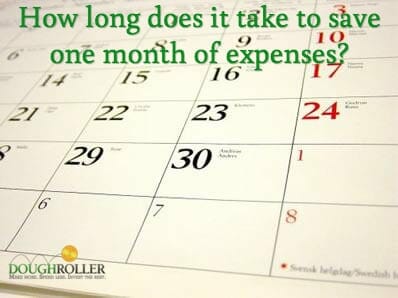Editorial Note: We earn a commission from partner links on Doughroller. Commissions do not affect our authors’ or editors’ opinions or evaluations. Learn more here.
 We often talk about the importance of saving an emergency fund. You’ve probably heard financial experts suggest building an emergency fund that is equal to three to six months’ worth of expenses. Have you ever thought about just how long it takes to save even one month of expenses?
We often talk about the importance of saving an emergency fund. You’ve probably heard financial experts suggest building an emergency fund that is equal to three to six months’ worth of expenses. Have you ever thought about just how long it takes to save even one month of expenses?
The formula to figure out just how long it will take is very simple. It’s also eye-opening.
First, let’s start with your after-tax income. Take this amount and divide it into two buckets – how much you spend and how much you save. Don’t forget to include savings and spending that come directly out of your paycheck (e.g., 401k contributions (saving) and health insurance premiums (spending)). Once you know how much you spend and how much you save, it’s easy to figure out how long it’ll take to save your month’s worth of expenses.
Take the percentage that you spend, and divide it by the percentage that you save.
For example, let’s say that you’re able to save 5% of your after-tax income. That would mean that you spend 95%. Ninety-five divided by five equals 19 months. So it would take you over one and a half years to save just one month’s worth of expenses. Let that sink in for a minute.
Of course, that doesn’t include any interest you might earn on that savings, perhaps in a high-yield savings account. But as you know, rates today are so low that you’re not going to get much help from interest. In fact, it’s less than the rate of inflation.
Regardless, 19 months is a long time to save a month’s worth of expenses. Do the math, and you’ll realize that saving six months’ worth of expenses will take you nearly 10 years.
So what if you doubled your savings rate to 10% while spending 90% of your take-home pay? Well, 90/10 is 9 months.
As you can see, the interesting thing here is that as you save more, you spend less. And since you spend less, you need less money, in total, to equal one month’s worth of expenses. So as you increase your savings rate, you’re getting a double bump. That’s why it takes less than half the time to save a month’s worth of expenses when you jump from a 5% savings rate to a 10% savings rate.
And it gets even better as you go. At a 20% savings rate, it would take you just four months to save a month’s worth of expenses. And at 50%? It’ll only take you one month to save a month’s worth of expenses.
(Think that can’t be done? Just check out this podcast where I interview Pete from Mr. Money Mustache who saved more than half his income and retired at age 30.)
Now all of this can be a little discouraging. Maybe you aren’t saving anything, or you’re only saving 5%. You may be stuck thinking about how long it’ll take to save an emergency fund.
That’s the bad news. The good news is that if you can get your savings rate up – even a little bit – those months needed to reach your goal drop quickly. That’s why my one-n-done method of saving money is so important.
This really underscores the importance of saving. It’s not easy, but if you can ratchet up the savings, the amount of an emergency fund you can set aside increases significantly. Of course, this also works for other types of savings. Whether it’s retirement or a child’s education, bringing your savings rate from 5 or 10% to just 10 or 15% helps tremendously. And if you can become a super-saver, putting away 20% or more of your income, you’ll really build wealth and achieve financial freedom very quickly.


